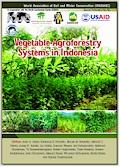| Book Chapter |
 |
|
| Title | Consumers' knowledge of and preference for indigenous vegetables: a market demand and consumption behavior analy | | Author | Lia Dahlia, Iwan Kurniawan, Denta Anggakusuma and James M Roshetko | | Editors | Anas D Susila, Bambang S. Purwoko, James M Roshetko, Manuel C. Palada, Juang G. Kartika, Lia Dahlia, Kusuma Wijaya, Arif Rahmanulloh, Mahmud Raimadoya, Tri Koesoemaningtyas, Herien Puspitawati, Tisna Prasetyo, Suseno Budidarsono, Iwan Kurniawan, Manuel Reyes, Wanraya Suthumchai, Karika Kunta and Samran Sombatpanit | | Year | 2012 | | Book Title | Vegetable-agroforestry systems in Indonesia | | Publisher | World Association of Soil and Water Conservation (WASWAC), Bangkok, Thailand and the World Agroforestry Center (ICRAF), Nairobi, Kenya | | City of Publication | Bangkok, Thailand | | Number of Pages of the book | 16 | | Pages | 231-246 | | Call Number | BC0333-12 | | Keywords | Consumer preference, indigenous vegetable, consumption behavior, Nanggung, agroforestry |
|
| Abstract: |
| Katuk (Sauropus androgynous), kucai (Allium odorum), honje (Ellingera elatior) and tebu telor (Saccharum of/icinarum) are four indigenous vegetables
that have a high market demand in greater Bogor and Jakarta, Indonesia. Demand
for all four commodities exceeds existing supply in village, subdistrict and city
markets. A consumers' preference survey was conducted to inform local small-
holder farmers, traders and other stakeholders on opportunities for expanding pro-
duction and commercialization of those indigenous vegetables. Data was col-
lected from 150 shoppers in three village markets, Leuwiliang subdistrict market,
and Bogor city market. Results indicated that city and subdistrict consumers are
more affluent, quality conscious, and willing to pay higher prices if commodities
are perceived to be scarce. City and subdistrict consumers visit markets a mini-
mum of weekly. They prefer markets as the main source of vegetables to meet
their household needs. Village consumers are price conscious and quality aware.
They visit markets less than monthly and will decrease their purchases if they per-
ceive prices are high or if quality low. Village consumers prefer to purchase vege-
tables directly from neighboring farmers rather than go to the market themselves
for both convenience and to save time and money. Consumers at all levels are
generally satisfied with commodity prices, availability and quality, but would in-
crease their purchases if availability and quality improved. City and subdistrict
consumers are willing to pay premium prices one to four times higher for high
quality commodities. This would provide farmers and traders the opportunity to
increase the production, processing and marketing of quality commodities. Com-
mercialization opportunities are better in lucrative city and subdistrict markets. In
serving this demand, farmers and traders need to be mindful of the additional
costs related to producing and transporting higher quality commodities. Katuk
and kucai are familiar to all consumers and demand for these products is strong.
Honje and tebu telor have positive market recognition, but are less familiar and
available to consumers in the lucrative markets. Efforts to expand marketing of
honje and tebu telor should include enhancing consumer awareness. |
|